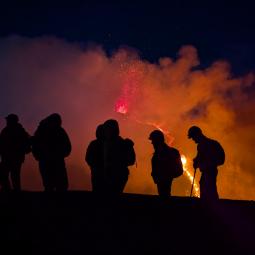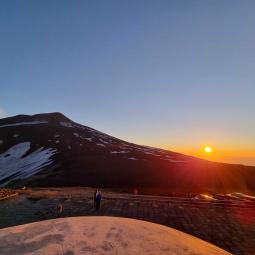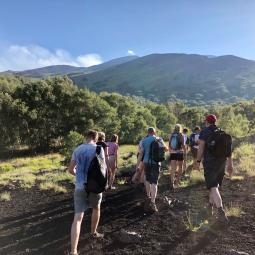
5 Best Documented Impacts of Mount Etna's Eruptions
Prepare to be amazed by the significant impacts of Mount Etna's eruptions on different facets of life. The consequences, well-documented and far-reaching, go beyond mere destruction. They shape landscapes, displace communities, and even alter cultural heritage sites. Delve into the five most thoroughly documented impacts to grasp the lasting influence of this formidable natural force.
Economic Disruption
Eruptions of Mount Etna have led to significant economic disruption in the surrounding region. The impact of these eruptions on the economy is profound, affecting various sectors like agriculture, infrastructure, and tourism. For instance, the 1669 eruption caused widespread destruction to crops, forests, and vineyards, leading to long-lasting consequences for Sicily's economy. Furthermore, the tourism industry, a vital source of income for the region, often faces setbacks due to eruption-related closures and safety concerns, resulting in financial losses for businesses and local communities, an example of a loss for the tourism industry is the large eruption of 2002 that wiped out two hotel, several shops and the dki-lift on Etna north side.
Repairing the damages caused by Mount Etna's eruptions is costly, requiring investments in rebuilding roads, structures, and utilities. These expenses can strain local businesses and government budgets, diverting resources from other essential services. Moreover, the economic impact extends beyond immediate losses to encompass long-term investments in disaster preparedness and recovery efforts. By understanding the economic disruptions caused by Mount Etna's eruptions, stakeholders can better prepare for and mitigate the financial consequences of future volcanic activities.
Environmental Changes
Mount Etna's volcanic activity has significantly altered the surrounding environment by reshaping landscapes and impacting air quality. The eruptions have caused extensive environmental changes, such as the destruction of vegetation and the creation of new landforms. Lava flows from Mount Etna haven't only destroyed human settlements and agricultural lands but have also influenced local ecosystems, leading to changes in flora and fauna distribution. The volcanic activity has shaped the surrounding environment, highlighting the dynamic interactions between the eruptions and the ecosystem.
Additionally, the impact of Mount Etna's eruptions on air quality can't be understated. The release of volcanic gases and ash clouds has affected the region's weather patterns and air quality, posing risks to the health of nearby populations. These environmental changes triggered by Mount Etna's eruptions emphasize the need for continuous monitoring and research to understand the long-term effects on the ecosystem and human health.
Social Displacement
The social displacement caused by Mount Etna's eruptions has had profound impacts on local communities, leading to significant disruptions in livelihoods and infrastructure. Throughout history, eruptions of Mount Etna have forced thousands of residents to flee their homes, with catastrophic events such as the 1669 eruption resulting in over 20,000 deaths.
The destruction of villages and towns due to lava flows has left lasting scars on the landscape and the people who once called those places home. In some cases, attempts to redirect lava flows, like during the Catania disaster, have unintentionally worsened the situation, increasing social displacement and chaos.
To mitigate such risks, regulations have been implemented to prevent interference with lava flows in Italy, aiming to safeguard communities from the dangers posed by volcanic activity. The social impacts of Mount Etna's eruptions underscore the importance of disaster preparedness, evacuation strategies, and community resilience in volcanic regions to minimize social displacement and protect lives.
Cultural Heritage Loss
Significant losses of cultural heritage sites, including ancient structures and artifacts, have been documented due to the volcanic activity of Mount Etna. The eruptions haven't only reshaped the physical landscape but also erased centuries-old cultural landmarks. Historical villages and buildings have succumbed to the destructive forces of lava flows and ash, leading to the disappearance of unique cultural elements and traditions tied to these areas.
Archaeological sites and cultural treasures have suffered damage or been buried under the volcanic debris, altering the historical narrative of the region. The destruction of cultural heritage during Mount Etna's eruptions hasn't only impacted the tangible aspects of history but has also contributed to the loss of valuable historical information.
The volcanic activity continues to pose a threat to the preservation of cultural heritage in the surrounding areas, highlighting the delicate balance between natural forces and human history.
Infrastructural Damage
Impacts of Mount Etna's eruptions extend beyond cultural heritage losses to include substantial damage to infrastructure, particularly in the form of destroyed roads, bridges, and buildings caused by lava flows. The volcanic activity has left a trail of destruction, with historical records revealing catastrophic outcomes.
Eruptions in 1669 and 1928 resulted in the obliteration of entire villages and farmlands encircling the volcano. To protect vital infrastructure during the 1983 eruption, authorities resorted to using dynamite to divert lava flows away from populated areas, showcasing innovative efforts. Urban centers like Catania have borne the brunt of Etna's fury, facing disruptions in transportation, utilities, and communication networks.
The aftermath of these eruptions necessitated extensive cleanup endeavors to restore the ravaged infrastructure and residential areas. Mount Etna's eruptions serve as a stark reminder of the raw power of nature and the imperative of preparedness in the face of such monumental forces.
Frequently Asked Questions
What Were the Impacts of Mount Etna?
Mount Etna's eruptions have had significant impacts, affecting air quality, transportation, agriculture, and tourism. New lava flows, ash clouds, and volcanic gases impact the region. Scientists monitor eruptions to understand volcanic processes and improve warning systems.
What Are the Recorded Eruptions of Mount Etna?
You've asked about the recorded eruptions of Mount Etna. This active volcano has had 71 eruptions from 1500 BCE to 1669 CE, with significant events in the 20th and 21st centuries, impacting surrounding areas and ecosystems.
What Were the Effects of the Mount Etna Eruption 1669?
The Mount Etna eruption in 1669 had significant impacts, causing deaths, heightening the volcano, and being historically violent. You could have escaped, but many stayed, resulting in casualties. The event marked a pivotal moment in Mount Etna's eruptive history.
What Are Some of the Benefits of Mount Etna Eruption?
You'll find benefits from Mount Etna eruptions like soil fertility boost, unique habitats, and research opportunities. The volcanic activity contributes to new landforms and attracts tourists, benefiting the economy and scientific progress in the region.
Conclusion
In conclusion, the impacts of Mount Etna's eruptions are far-reaching, affecting various aspects of society and the environment. From economic disruptions to cultural heritage loss, each eruption leaves a lasting impact on the region.
Understanding these consequences is crucial for implementing effective disaster preparedness measures and mitigating future risks. By studying the documented impacts of past eruptions, we can better equip ourselves to handle the challenges posed by Mount Etna's volcanic activity in the future.





